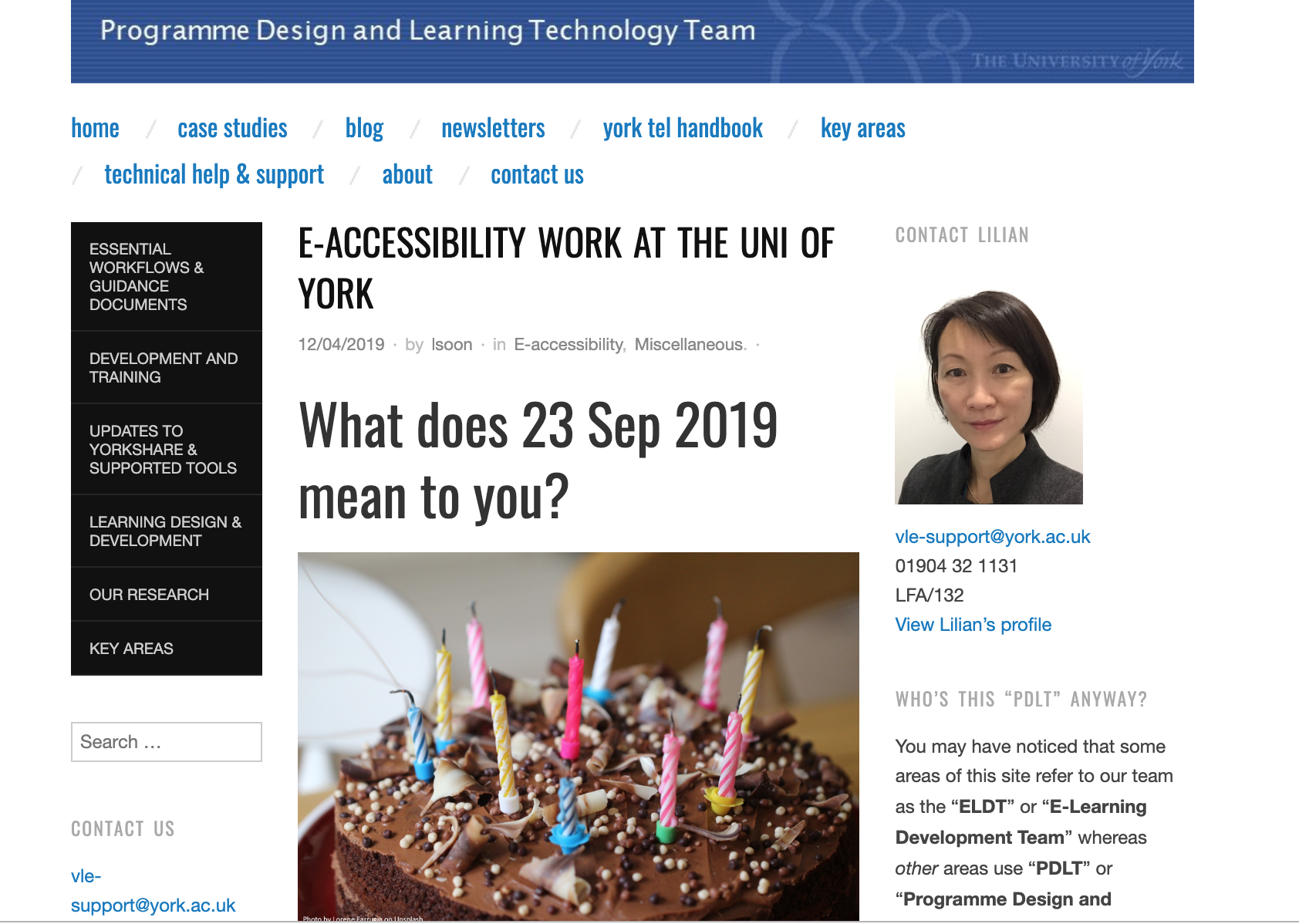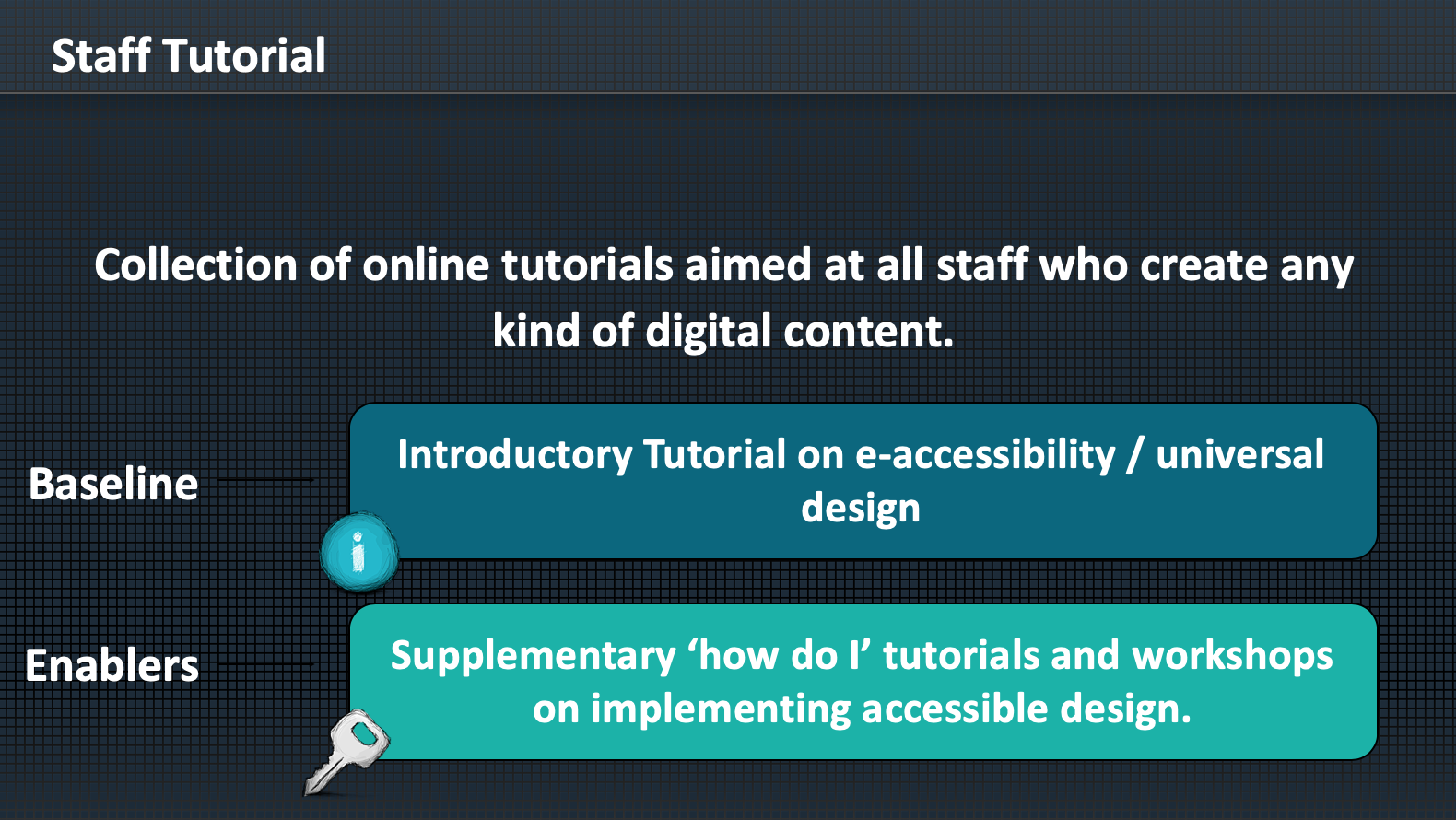How York University is meeting accessibility regulations
Annie Mannion | 30 Sep 2019The UK's new digital accessibility regulations have created a new set of requirements for universities, colleges and other public sector organisations. The details have been covered by AbilityNet in a variety of recent articles, but in this post we turn to the University of York to see what steps they are taking to rise to the challenges they face.
Richard Walker heads up the Programme Design and Learning Technology Team at the University of York. His team manages the university's e-learning platforms, including its virtual learning environment (VLE), lecture recording and e-assessment solutions, and the provision of training and support for staff. This means that they must work with other departments to explore aspects of design and delivery to ensure an outstanding learning experience for its students.
He offers these six steps to help you think about an approach which you could adapt for your institution.
1. Embedding a digital inclusion approach
 The University of York has a long-standing commitment to digital inclusion and accessibility, but even if your institution is still finding its way this is the perfect time to establish good practices.
The University of York has a long-standing commitment to digital inclusion and accessibility, but even if your institution is still finding its way this is the perfect time to establish good practices.
For example, the University of York set up an e-Accessibility Forum in 2007, bringing together staff and students with responsibility for ensuring that its online resources for teaching/learning, research, administration and knowledge transfer are accessible to all - which helps the university meet its statutory obligations under the Equality Act.
In recent years the University has also established an Inclusivity Strategy Group (ISG) to further develop and embed a digital inclusion approach. A new e-accessibility working group was set up in November 2018 to lead its response to the new EU regulations on the Accessibility of Public Sector Websites and Mobile Apps, which came into force on 23 September 2019.
2. Conduct user testing to aid procurement decisions
Your institution may be in the midst of making decisions about which new e-learning tools you should roll out, or which new content management system to choose, for example. The focus for the University of York has been to actively consider accessibility issues during the procurement - rather than after staff and students start discovering problems once the systems are in use.
To help with this, Richard's team has worked in partnership with the Department of Computer Science’s Human Computer Interaction research group. They run accessibility and usability testing on all major software upgrades for the VLE, and this testing has also been introduced to VLE procurement decision-making.
"What we have learned is that vendors’ assertions of compliance with accessibility standards cannot be taken at face value – so a tick box approach to verifying accessibility compliance is not sufficient," says Richard. "The other issue is that the Web Content Accessibility Guidelines (WCAG) are designed for web content only and are difficult to apply to complex systems such as enterprise-wide learning management systems, for which standards are not precise enough."
So what's the answer?
The University of York now tests these more complex systems with real users, who provide first-hand accounts of accessibility and usability challenges through the use of a ‘thinking aloud’ protocol, capturing the challenges as users encounter them in tackling a predefined task.
"My team has developed user scenarios, based on authentic academic activities, and use real subjects to perform these scenarios using the targeted software," says Richard. "With this testing employed for major upgrades and as part of decision-making for software procurement it's helped us to identify and report accessibility issues directly to the vendor."
The team also gathers accessibility issues via staff and student surveys, and then converts its findings into targeted guidance to programme teams in its York Staff Handbook.
3. Approach the Board for buy-in as soon as possible...
Before you can identify your digital accessibility needs and issues, and make necessary subsequent organisational-wide changes, you need to ensure your management team fully understands the impact of the regulations, and its responsibilities towards meeting them.
Knowing that the new public sector digital accessibility regulations were imminent, Richard's team gathered recommended actions for consideration. For example, they knew they would need for an accessibility audit of its VLE and website, plus awareness-raising and training sessions on the new regulations. They then presented these suggestions to the University Executive Board, with associated costs.
As a result, the team was able to put together a broad delivery programme, which included:
- Two senior sponsors within the University.
- Consultation with Jisc through its Accessibility Snapshot service in March 2019
The consultation with an external agency such as Jisc provided the team with valuable feedback on website navigation and structure, and a clear set of priority actions to address - for example, reducing the number of keyboard tabs required to access its institutional accessibility statement, by providing a skip link directly to the statement.
"Evidence based decision making helps to inform an appreciation of the key priorities that need to be tackled by a department or programme team," says Richard. "It’s important to be pragmatic about how you approach the accessibility regulations – it’s not possible to fix everything at once."
4. Engaging and training staff in accessibility best practice
 Embedding 'accessibility first' thinking within your institution will be tough without full understanding and engagement from staff about the importance and goals of the regulations. So think about the awareness-raising approaches and training sessions you could create, and which teams or individuals you could involve in the process.
Embedding 'accessibility first' thinking within your institution will be tough without full understanding and engagement from staff about the importance and goals of the regulations. So think about the awareness-raising approaches and training sessions you could create, and which teams or individuals you could involve in the process.
"Focus should be first on awareness-raising and the education of staff, so that they are fully aware of the importance of accessibility principles and the drivers for them and do not see this simply as a compliance obligation, with an additional workload imposed on them from on high," says Richard. "It's also important to engage across silos."
The cross-services e-accessibility working group set up in 2018 provided a way to create an institutional response to the regulations, identifying key actions and an implementation plan. The group includes representatives from Digital Communications, the Equality and Diversity Office, Programme Design and Learning Technology Team, as well as representatives from undergraduate and graduate student associations.
The e-accessibility working group has also identified examples of existing excellent practice within the university, as well as areas where a greater focus on inclusivity can be developed. It also shared relevant information and training about the regulations across the staff and student cohort:
- Created series of blogs (see an example blog on its website, with a screenshot included on this page);
- Communicated news of the regulations widely within the university:
- Established a programme of briefing sessions on the new accessibility regulations to stakeholder groups,
- Delivered a series of central workshops on digital accessibility, focusing first on strategies for creating accessible documents.
- Delivered a varied programme of training to staff on accessibility issues and how they impact on the user experience, including 1:1 sessions, show and tell briefings on inclusive practice and webinars.
- This included looking at the presentation of documents, plus workshops which have a specific focus on accessibility.
"It has been really encouraging to see a strong take-up for these sessions, with over 70+ colleagues attending two-hour sessions," says Richard.
 The team also developed an online self-paced tutorial course about creating accessible learning resources, aimed at anyone developing modules and teaching with University's VLE. This course enables academic staff to:
The team also developed an online self-paced tutorial course about creating accessible learning resources, aimed at anyone developing modules and teaching with University's VLE. This course enables academic staff to:
- identify their obligations to students with special needs
- apply document structure and styles
- evaluate their learning materials for accessibility; and
- identify accessibility features in common software that can aid students with disabilities.
Tutorials need to be completed by all staff who create any digital content, where that content is aimed at staff or students.
5. Tackling trickier accessibility tasks
While there are a set of clear requirements outlined within the new EU regulations on the Accessibility of Public Sector Websites and Mobile Apps, such as ensuring you have an Accessibility Statement with the correct information included, there are some content items that may be more problematic to fix in the short term.
Here are some of the problem areas that the University of York identified:
Diagrams and graphs
"Dealing with the volume of content such as diagrams and graphs that require some form of meaningful description addressing the key learning points that are being conveyed to students - there are no quick fixes to come up with these descriptions for resources, which could be in hand-written form, " says Richard.
In some cases, existing software provision is not up to scratch in helping staff to comply with the regulations, Richard says. "For example, screen reader software struggles to read equations that are inserted into Word / PowerPoint files using equation editors and we are looking for better ways of presenting mathematical and scientific notation in an accessible fashion."
Difficulty interpreting the exact requirements of the regulations
"Many colleagues found that the regulations are drafted in such a way that they are open to interpretation," explains Richard. "For example, in terms of meeting the compliance deadline of September 2019 for existing content resources which have undergone a ‘substantial revision’, we need a clear definition of what this means," says Richard.
Abi James is one of AbilityNet's accessibility consultants with extensive experience working with HE institutions. She advises "There has been a lot of work across the university sector to engage with the government on how to implement the regulations and that has resulted in the publication of a toolkit on the LexDis website. While it can be more difficult to implement change when the regulations are clear cut, organisations such as universities have always had a responsibility to anticipate the needs ot disabled staff and students, which has included provisions in accessibilty content. These new regulations really provide a framework to improve transparency for users and make sure all organisations are working to improve accessibility."
Third party and multimedia content
There is a challenge in how institutions manage third-party content and the procurement process for software tools. Video is also an area of concern for the University of York.
"More than 1,000 recordings are created at York per week during term time so we face a major challenge in tackling captioning/subtitling of these recordings. This is a challenge related to the volume of activity and the accuracy or immaturity of automated captioning services, which are not at the level of accuracy that we require. At this stage we are wondering whether be can claim disproportionate burden, but like most people need that to be clarified as the enforcement process unfolds."
Abi is keen to emphasise the need for universities to engage with suppliers, such as captioning services. "It's really important that we engage with suppliers so they understand the accessibility requirements of the sector. Purchasing consortium can help and the University of Kent, for example, has worked with its local consortium to develop guidance for procurement."
6. Top 3 challenges for HE-specific accessible content?
As part of your analysis of your website and VLE content you may identify some key developments that would greatly help to ensure your digital accessibility. Richard outlines his three key 'wishes' for digital accessibility:
- We need in-built accessible content-authoring tools, so that the default is to generate content which is born accessible. Ideally we would like to see accessible templates provided as part of the content creation tools within the VLE and other key systems.
- We need a solution to providing descriptions to graphs and figures, and the presentation of equations in an accessible fashion. There are work-arounds for these challenges, but the challenge is in the volume of material that we need to address.
- We need software vendors to fully engage with the requirements of the new regulations. One obvious area of concern is video, where we need better (more accurate captioning / transcription services).
Do you know of any tools that can help with these goals? Do get in touch if so.
Further information about HE and FE accessibility
AbilityNet has a range of resources and guidance to help to comply with the new regulations:
- 10 steps to comply with new accessibility regulations - from Abi James, experienced HE Accessibility consultant with AbilityNet
- University of Kent case study: Creating a more accessible learning environment
- Sign up to our enewsletter for regular accessibility updates.
- Download our series of higher education (HE) online workshops, hosted by Abi James.
- Looking for help knowing where to start with approaching your accessibility needs? Take a look at our resources for higher education institutions.
- Contact us to discuss your accessibility, review, training or audit needs.
- Visit the LexDis website for a selection of resources about the regulations.



